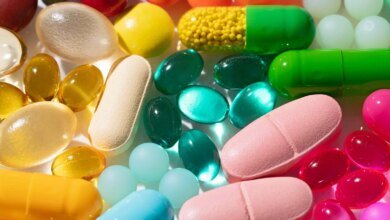7 Teas To Help Lower Your Blood Pressure Naturally

7 Teas To Help Lower Your Blood Pressure Naturally
Many people are interested in natural ways to help manage their blood pressure along with medication. High blood pressure, or hypertension, increases your risk of heart disease and stroke.One simple option that may make a difference is tea.
It’s not a substitute for medical treatment, but making tea part of your routine can be a small but effective step toward better heart health.
a و blood و your – تفاصيل مهمة
Hibiscus tea is made from the dried petals of the hibiscus flower. It’s caffeine-free and has a bright, tart flavor.
Hibiscus gets its deep red color fromanthocyaninsthe same antioxidant compounds found in berries and other red or purple fruits.These antioxidants maysupport the health of your blood vessels and promote their ability to relaxwhich in turn may help reduce blood pressure.
Several studies suggest that hibiscus tea can have real benefits for people with high blood pressure. In one study, people who dranktwo cups of hibiscus tea dailysaw significant drops in both their top (systolic) and bottom (diastolic) blood pressure readings compared to a placebo group.
and و blood و tea – تفاصيل مهمة
A review of multiple studies also found that hibiscus tea consistently lowered systolic blood pressure, with a smaller effect on diastolic pressure.
Green, black, and oolong teas come from the sameCamellia sinensisplant, but they are processed differently. Oxidation, or exposure to oxygen after harvesting, influences a tea’s flavor, color, and nutrients. Green tea is not oxidized, preserving its mild flavor and antioxidant compounds.
One of the key antioxidants in green tea,catechinsmayhelp keep blood vessels flexibleand promote better circulation. These compounds alsohave anti-inflammatory effectsthat support overall cardiovascular health.
and و the و Green, – تفاصيل مهمة
Research suggests that regularly drinking green tea may have a small but meaningful effect on blood pressure. People who consume it consistently, especially those with borderline high blood pressure or other cardiovascular risks, see reductions in both systolic and diastolic blood pressure readings.
Most studies suggest thattwo to four cupsof green tea a day are enough to see benefits. Because green tea contains caffeine, people who are sensitive may prefer smaller amounts or a decaffeinated option.
Chamomile tea is best known for helping you relax and unwind, but it may also support healthy blood pressure. Stress and poor sleep are linked to a higher risk of high blood pressure. Chamomile’s calming properties may help indirectly bypromoting better rest.
to و tea و a – تفاصيل مهمة
Chamomile also contains flavonoids and phenolic acids, plant compounds that act as antioxidants thatmay help reduce inflammation in the body. While research directly linking chamomile to lower blood pressure is limited, these antioxidants may help reduce oxidative stress and support healthy blood vessel function.
Black tea is made from the sameCamellia sinensisplant as green tea, but the leaves are fully oxidized, giving it a rich flavor and darker color. It’s a natural source of flavonoids that may helpprotect blood vessels,reduce inflammationandsupport healthy circulation.
Several studies have found that people who drink black tea regularly (typicallytwo to five cupsper day) tend to have lower blood pressure than those who don’t. The effects are modest, but even small reductions can make a meaningful difference for heart health.
a و tea و the – تفاصيل مهمة
Like green tea, black tea contains caffeine, so it might not be ideal for those sensitive to stimulants.
Oolong tea is partially oxidized, meaning it falls somewhere between green and black tea in both color and flavor. It contains a blend of beneficial compounds like catechins, theaflavins, and other polyphenols with antioxidant properties.
There’s less research on oolong tea than on green or black tea, but some studies suggest itmay help lower blood pressure. In one trial, people who drank GABA-enriched oolong tea showed improvements in both systolic and diastolic blood pressure.
tea و and و it – تفاصيل مهمة
Most commercially available oolong tea doesn’t contain GABA (gamma-aminobutyric acid). GABA is a neurotransmitter that helps calm the nervous system. research is needed to understand whether oolong without GABA has the same effect, but its mix of antioxidants and anti-inflammatory compounds may also support healthier blood vessels.
Some studies have also linked oolong tea with alower likelihood of developing hypertension. An older, long-term study from 2004 found that those who enjoyedat least half a cupof oolong or green tea each day were up to 46% less likely to develop high blood pressure, with greater benefits seen among those who drank multiple cups daily. current research is needed.
When fresh garlic is crushed or chopped, it releases allicin, a sulfur compound linked to reduced oxidative stress and better circulation. Research suggests that allicinmay help relax blood vesselsand modestly lower blood pressure.
a و to و blood – تفاصيل مهمة
Research on garlic tea itself is limited, but studies on garlic supplements show promising results. People who regularly consume garlic supplements have significant reductions in both systolic and diastolic blood pressure, especially those with existing hypertension.
If you want to try garlic tea, simmer chopped or crushed garlic cloves in hot water, then add lemon or honey to soften the flavor.
Ginger tea is warming, spicy, and often used to support digestion, but it also may offer cardiovascular benefits. While research is needed on ginger tea specifically, compounds in ginger appear tohelp relax blood vessels,reduce inflammationandsupport healthy circulation.
to و garlic و or – تفاصيل مهمة
A study of than 4,000 adults found that those who consumed ginger regularly had alower risk of developing hypertension.Smaller clinical trials and meta-analyses also suggest that ginger intake (including tea or supplements) can modestly lower both systolic and diastolic blood pressure.
Not every tea supports healthy blood pressure. Some can have the opposite effect or interact with medications. These include:
- Licorice tea:Licorice root containsglycyrrhizina compound that can cause the body to retain sodium and lose potassium. Glycyrrhizin can raise blood pressure and may also interact with certain medications.
- Highly caffeinated teas:Caffeine can temporarily raise blood pressure, particularly in people who don’t consume it regularly. Since sensitivity varies from person to person, it’s best to monitor how caffeine affects you and start with smaller amounts.
- Energy, fat-burning, or “detox” teas:Some blends include stimulants or extra ingredients that may raise heart rate or blood pressure.
blood و can و or – تفاصيل مهمة
If you have high blood pressure, drinking tea can be a simple way to support blood pressure alongside other healthy habits. If you’re concerned about your blood pressure or are curious about the impact of drinking tea, check it regularly and keep a record of your readings so you can share any trends or changes with your doctor.
Disclaimer: This news article has been republished exactly as it appeared on its original source, without any modification.
We do not take any responsibility for its content, which remains solely the responsibility of the original publisher.
Author:Caitlin Beale, MS, RDN
Published on:2025-11-05 02:00:00
Source: www.health.com
Disclaimer: This news article has been republished exactly as it appeared on its original source, without any modification.
We do not take any responsibility for its content, which remains solely the responsibility of the original publisher.
Author: uaetodaynews
Published on: 2025-11-04 23:22:00
Source: uaetodaynews.com





